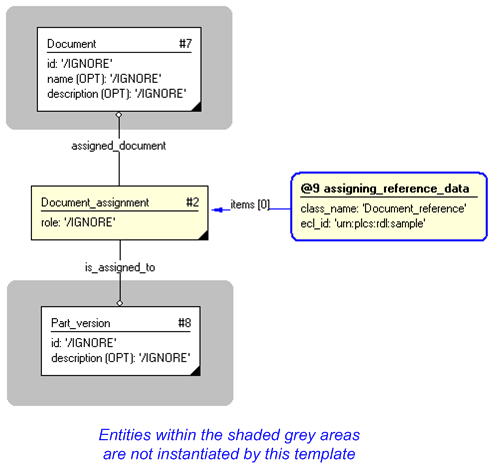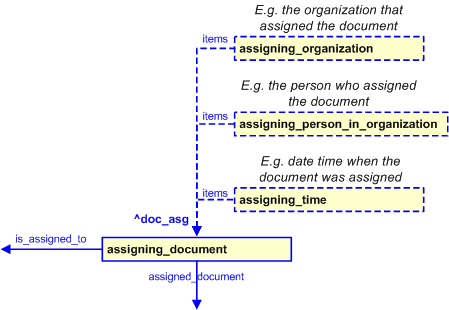| Template:— assigning_document (asg_doc) |
Date: 2008/01/28 09:42:56
Revision: 1.19
|
This section specifies the template assigning_document.
NOTE
An explanation of a template and the associated instantiation path is
provided in the
Template overview
section.
This template describes how to assign a document to an item. It does not create the
document entity instance to be populated, nor does it create the item to which the document
is to be assigned to - these are the subject of separate templates. This template only
facilitates the assignment.
The EXPRESS-G diagram in
Figure
1
shows the templates and EXPRESS entities that are required
to represent the template
"assigning_document".
The text highlighted in blue shows the template parameters.
Figure 1 — An EXPRESS-G representation of the Information model for assigning_document
The graphic for the template to be used in other EXPRESS-G diagrams
is shown in Figure
2
below.
Figure 2 — The graphical representation of the assigning_document template
The following input parameters are defined for this template:
The name of the
External_class being used to
determine the role of the assignment.
The following classes and their sub-classes can be used:
The following reference parameters are defined for this template:
Allow the
Document_assignment
entity instantiated in this path to be referenced when this template is used.
%^target = $assigning_document.doc_asg%
The instantiation path shown below specifies the entities that are to be
instantiated by the template.
A description of templates and the syntax for the instantiation path is
provided in the
Templates Help/Information section.
The following entities are instantiated with attributes as specified:
The instance diagram in Figure
3
shows an example of the EXPRESS entities and templates that are instantiated by the template:
/assigning_document(assigned_document='#7', doc_ass_role='Document_reference', doc_ar_ecl_id='urn:plcs:rdl:sample', is_assigned_to='#8')/
(an illustration of the consolidated assigning_document template is shown in
Figure
4 below.)
Figure 3 — Entities instantiated by assigning_document template
The instance model in STEP ASCII exchange file format (ISO 10303 Part
21 syntax) is:
#2 = DOCUMENT_ASSIGNMENT(#7,#8,'/IGNORE');
#7 = DOCUMENT('/IGNORE','/IGNORE','/IGNORE');
#8 = PART_VERSION('/IGNORE','/IGNORE',$);
#10 = CLASSIFICATION_ASSIGNMENT(#12,(#2),'/IGNORE');
#12 = EXTERNAL_CLASS('/NULL','Document_reference','/IGNORE',#13);
#13 = EXTERNAL_CLASS_LIBRARY('urn:plcs:rdl:sample',$);
The instance diagram in
Figure
4
shows the graphic symbol for the template that is to be
used in other instance diagrams. The example template is:
/assigning_document(assigned_document='#7', doc_ass_role='Document_reference', doc_ar_ecl_id='urn:plcs:rdl:sample', is_assigned_to='#8')/
Figure 4 — Invocation of assigning_document template example - graphical presentations
The following section details how the
assigning_document
template can be optionally characterized by assigning
other constructs to it. These are characterizations commonly
applied to the template. The ISO 10303-239 EXPRESS model may enable
other assignments to the entities instantiated by the template.
The EXPRESS-G diagram in Figure
5
shows the possible characterizations of the template
"assigning_document".
Figure 5 — Possible characterizations of the assignment of a document.
The following characterizations may apply:
Characterization Assigning date time
NOTE this characterization is optional.
Characterization Assigning organization or person in organization
NOTE this characterization is optional.





